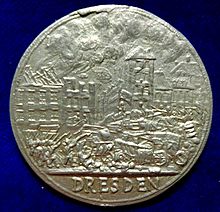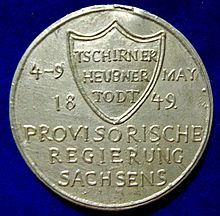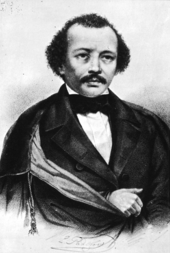Dresden May Uprising
The Dresden May Uprising from May 3 to 9, 1849, also known as the Dresden May Revolution, was an attempt to overthrow King Friedrich August II of Saxony and establish a Saxon republic as part of the imperial constitution campaign towards the end of the German Revolution of 1848/1849 . After the suppression of this uprising, the March Revolution in Saxony came to an end, just under three months before its final suppression in the states of the German Confederation through the surrender of the Rastatt fortress in Baden.
prehistory
The year before, at the beginning of the March Revolution , in Saxony, as in many other states of the German Confederation and Central Europe , starting from the February Revolution in France in 1848 , there had been liberal and democratically motivated revolutionary unrest, alongside the liberalization of the German principalities also aimed at the national unification of the states of the German Confederation in a unified German Reich . An essential step in this direction was the demand for an all-German constitution , which was drawn up in the newly created, democratically elected National Assembly in the Paulskirche in Frankfurt .
The revolutionary uprisings in Saxony as in other principalities in 1848 initially resulted in the ruling princes giving in. The establishment of liberal March ministries , the lifting of censorship , the liberation from feudal burdens and other progressive measures had come about . Starting from the most powerful states in the Federation, Prussia and Austria , the counterrevolution gradually established itself as early as the summer of 1848 . The Frankfurt National Assembly had no means of its own to enforce its legitimacy . When, after long controversial debates, the National Assembly finally presented a constitution that provided for an all-German constitutional monarchy within a small German framework, i.e. without Austria, under Prussian leadership, King Friedrich Wilhelm IV of Prussia rejected the imperial dignity that had been proposed to him . The Prussian and Austrian MPs left the National Assembly after their governments declared their mandates to have expired. Even Friedrich August II. Of Saxony was one of the opponents of this Constitution and a Constitutional all-German monarchy . The constitution, and with it German unification , had initially failed.
In order to secure the most important liberal advances in the individual states, the imperial constitution campaign was launched in some states . In this context, radical democratic revolutions followed in some states, the May uprisings of 1849. In addition to Saxony, this was also the case in the Grand Duchy of Baden, for example (see also the Baden Revolution ). The Dresden May Uprising was the last attempt in Saxony to enforce the achievements of the March Revolution there.
course

On May 3, 1849, the open uprising broke out in Dresden . Due to the deployment of the Saxon army in the Schleswig-Holstein War, there were only 1,800 men with six drawn guns in the city. The Dresden arsenal was stormed, the state parliament building occupied by armed members of the Turner movement . On May 4th, at 4:30 a.m., the King, Queen and all the ministers left the city and went to Königstein Fortress . The country was without a government; the authorities had not even been informed of the ministers' departure. Tzschirner , Heubner and Todt - members of the dissolved Saxon state parliament - appointed a "provisional government". The former Greek officer Heinze had been elected commander of all Saxon vigilante groups . The Russian revolutionary Mikhail Bakunin arrived in Dresden on the same day and took part in leading the uprising. Prussian and Saxon troops under Colonel Friedrich von Waldersee put down the rebellion in the days of the 7th, 8th and 9th May. The leaders Tzschirner, Heubner and Bakunin initially escaped. Likewise, Richard Wagner , who was the court conductor at the time and who was friends with Bakunin, who was involved in the uprising , and the builder Gottfried Semper, who was friends with Wagner, and the writer Friedrich Herman Semmig were also able to flee the city. The state of siege was declared for Dresden, but it was not enforced.
When a Prussian unit of eleven infantry battalions and two cavalry regiments of the Landwehr under Heinrich von Holleben arrived on the train in Dresden on May 10, the barricade fight had been over for hours and the revolutionaries had fled the city. Holleben crossed Saxony with his troops, with neither fighting nor mass arrests. On May 25, the association arrived at the Prussian fortress of Erfurt , from where it was relocated to the Neckar region to fight the Baden Revolution .
Bakunin was captured soon after the uprising in Chemnitz and later sentenced to death, pardoned to life imprisonment in 1851 and finally extradited to Russia , where he remained imprisoned for another 10 years until he fled.
Involved troops of the Saxon and Prussian armies
Saxon troops:
- 6 companies of the light infantry
- III. Battalion of the Leib Grenadier Regiment
Prussian troops:
- 1st Battalion and Fusilier Battalion of the Emperor Alexander Guard Grenadier Regiment No. 1
- Fusilier battalion from the infantry regiment "Grand Duke Friedrich Franz II. Of Mecklenburg-Schwerin" (4th Brandenburg) No. 24
losses
The light infantry of the Saxon and Prussian armies suffered six deaths and twelve wounded. The total losses of the Saxon and Prussian troops are given as 31 dead and 94 wounded. Most of the dead among the insurgents were young men; they formed the core of the fighters. Of the 99 identified dead, around 40 were not from Dresden, 98 of the unknown dead were found. Of the 114 wounded, only 67 were from Dresden. The total number of dead and wounded on the side of the people's fighters was thus 343 people. Schuster speaks of around 250 dead and 400–500 wounded.
Commemoration
Three bronze plaques by Martin Hänisch commemorate the May Uprising in Dresden . They are located on Tzschirnerplatz on the east side of the Albertinum (former Dresden armory ), at the seat of the Provisional Government at Altmarkt 25 (former location of the town hall ) and at the location of the barricades at Schloßstraße 7.
See also
literature
- Franz Mehring : The May Uprising in Dresden . In: The True Jacob . Stuttgart 1899, No. 332, pp. 2968-2970.
- Michael Bakunin, Gottfried Semper, Richard Wagner and the Dresden May Uprising in 1849. Friedrich-Ebert-Stiftung - Research Institute, Bonn 1995, ISBN 3-86077-473-5 .
- Armin Gebhardt: The Dresden May Revolution 1849. Tectum-Verlag, Marburg 2006, ISBN 3-8288-9145-4 .
- Bernd Kramer: Michael Bakunin, Richard Wagner and others during the Dresden May Revolution in 1849. Kramer, Berlin 1999, ISBN 3-87956-201-6 .
- Hans-Peter Lühr (Red.): The Dresden May Uprising of 1849 . Dresdner Geschichtsverein, Dresden 1995, ISBN 3-910055-30-3 ( Dresdner Hefte 13, 3, 1995 = No. 43).
- Josef Matzerath (ed.): The Saxon King and the Dresden May Uprising. Diaries and notes from the revolutionary period 1848/49. Böhlau, Cologne a. a. 1999, ISBN 3-412-15098-3 ( sources and materials on the history of the Wettins 1).
- Robert Reinick : From Biedermeier days. Letters from Robert Reinick and his friends. Edited by Johannes Höffner. Velhagen & Klasing, Bielefeld u. a. 1910.
- Martina Schattkowsky (Ed.): Dresden May Uprising and Imperial Constitutional Campaign 1849. Revolutionary aftershock or democratic political culture? Leipziger Universitätsverlag, Leipzig 2000, ISBN 3-934565-16-6 ( Writings on Saxon State History 1).
- Oskar Wilhelm Schuster , FA Franke: History of the Saxon Army , Leipzig 1885
- Horst-Ulrich Textor: The Revolution in Saxony 1848/49. Freiberg mountain students on the barricades in Dresden . Once and Now , Volume 59 (2014) [in press].
- Friedrich von Waldersee : The fight in Dresden in May 1849 . Described and militarily illuminated with special consideration for the participation of the Prussian troops . ES Mittler & Sohn, Berlin 1849, pp. 5, 74, 77f., 80; with a battle plan ( Wikisource ; books.google.com.eg ).
- Carl Munde: My escape from Dresden to New York in 1849 . In: The Gazebo . Issue 10 and 11, 1867, pp. 152–156, 168–171 ( full text [ Wikisource ]).
Literary adaptations
- Marie Norden : Dresden's May Days. A picture of time . A. Wienbrack, Leipzig 1850
- Katrin Lange : Heubner's sofa or Richard Wagner on the barricades. A post-revolutionary consideration ( radio play ), Ursendung 1998, Deutsche Welle
Web links
- Literature from and about the Dresden May Uprising in the Saxon Bibliography
- For the 160th anniversary of the Dresden May Uprising. Archive of Social Democracy (AdsD) of the Friedrich-Ebert-Stiftung
- Revolution in Dresden from May 3rd to 9th, 1849 - Documentation on the Dresden May Uprising with historical images on neumarkt-dresden.de
Individual evidence
- ↑ Hugo Dinger: Richard Wagner's intellectual development. Attempt to present Richard Wagner's worldview, taking into account its relationship to the philosophical directions of the Young Hegelians and Arthur Schopenhauer . EW Fritzsch, Leipzig 1892, p. 226.
- ^ Friedrich von Waldersee : The fight in Dresden in May 1849 . ES Mittler & Sohn, Berlin 1849, pp. 5, 74, 77f., 80.
- ↑ a b c Captain Knight and Noble Lord v. Berger: History of the King. Saxon. Prince Georg Rifle Regiment No. 108
- ↑ Schuster Part III p. 65
- ^ Art in public space , information brochure of the state capital Dresden, December 1996
- ^ Pseudonym of Friederike Ernestine Wolfhagen (1812–1878).





